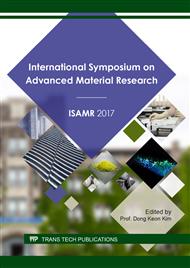[1]
S. Lanfredi, M. A. Nobre, Conductivity mechanism analysis at high temperature in bismuth titanate: A single crystal with sillenite-type structure, Appl. Phys. Lett. 86(8) (2005) 081916.
DOI: 10.1063/1.1869542
Google Scholar
[2]
S. Lanfredi, J. F. Carvalho, and A. C. Hernandes, Electric and dielectric properties of Bi12TiO20 single crystals, J. Appl. Phys. 88 (1) (2000) 283-287.
DOI: 10.1063/1.373654
Google Scholar
[3]
R. A. Castro, N. I. Anisimova, G. A. Bordovsky, V. A. Bordovsky, Correlation between bismuth concentration and distribution of relaxators in As2Se3(Bi)x layers, J. Non-Crystalline Solids, 352(9) (2006) 1560-1562.
DOI: 10.1016/j.jnoncrysol.2006.01.031
Google Scholar
[4]
N. I. Anisimova, V. A. Bordovsky, G. I. Grabko, R. A. Castro, Features of the charge transfer in structures based on thin layers of bismuth-modified arsenic, Semiconductors, 44(8) (2010) 1004-1007.
DOI: 10.1134/s1063782610080075
Google Scholar
[5]
V. T. Avanesyan, G. A. Bordovskii, R. A. Castro, Relaxation dark currents in As-Se glasses, Glass Phys. Chem. 26(3) (2000) 257-259.
DOI: 10.1007/bf02738293
Google Scholar
[6]
R. H. Chen, R. J. Wang, T. Chen, C. S. Shern, Studies on the dielectric properties and structural phase transition of K2SO4 crystal, J. Phys. Chem. Solids, 61(4) (2005) 519-527.
Google Scholar
[7]
L. Sirdeshmukh, K. Krishna Kumar, S. B. Laxaman, A. R. Krishna, G. Sathaiah, Dielectric properties and electrical conduction in yttrium iron garnet (YIG), Bull. Mater. Sci. 21(3) (1998) 219-226.
DOI: 10.1007/bf02744973
Google Scholar
[8]
R. P. Mahajan, K. K. Patankar, M. B. Kothale, S. A. Patil, Conductivity, dielectric behavior and magnetoelectric effect in copper ferrite-barium titanate composites, Bull. Mater. Sci. 23(4) (2000) 273-279.
DOI: 10.1007/bf02720082
Google Scholar
[9]
B. Lal, S. K. Khosa, R. Tickoo, K. K. Bamzai, P. N. Kotru, Dielectric characteristics of melt grown doped KMgF 3crystals, Mater. Chem. Phys. 83(1) (2004) 158-168.
DOI: 10.1016/j.matchemphys.2003.09.011
Google Scholar
[10]
K. Amarendra Singh, T. C. Goel, R. G. Mendiratta, P. Chandra, Dielectric properties of Mn-substituted Ni-Zn ferrites, J. Appl. Phys. 91(10) (2002) 6626-6629.
DOI: 10.1063/1.1470256
Google Scholar
[11]
S. N. Mustafaeva, Dielectric properties of TlGa1–xFexSe2 single crystals in the alternate electric fields, J. Radioelectron. 5 (2008) 1-11.
Google Scholar
[12]
M. Pollak, T. Geballe, Low-Frequency Conductivity Due to Hopping Processes in Silicon, Phys. Rev. 122 (1961) 1742.
DOI: 10.1103/physrev.122.1742
Google Scholar
[13]
V. Marinova, V. Sainov, S.H. Lin, K.Y. Hsu. DC and AC conductivity measurements of Bi12TiO20 photorefractive crystals doped with Ag, P, Cu and Cd, Jpn. J. Appl. Phys. Vol 41 (2002), pp.1860-1863.
DOI: 10.1143/jjap.41.1860
Google Scholar


